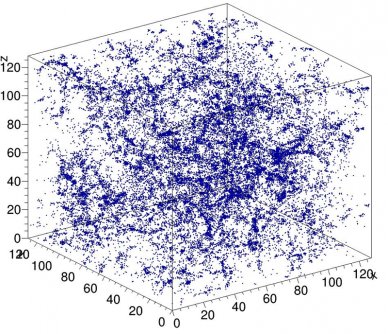The Science
How do you determine the measurable “things” that describe the nature of our universe? To answer that question, researchers used CosmoFlow, a deep learning technique, running on a National Energy Research Scientific Computing Center supercomputer. They analyzed large, complex data sets from 3-D simulations of the distribution of matter to answer that question. The team showed that CosmoFlow offers a new platform to gain a deeper understanding of the universe.
The Impact
Deep learning is a powerful way to figure out relationships between variables in complex data. It has been widely developed and adopted by industry. However, applying it to scientific data presents unique challenges. For example, scientific data is often more complex (3-D and 4-D) and voluminous (terabytes and petabytes of data) than the data found in commercial applications. By using CosmoFlow and similar applications to study the distribution of matter at the largest scales, scientists can learn more about the physics of the universe involving gravity, dark matter, and dark energy.
Summary
In cosmology, the study of dark matter and dark energy has taken
on an increasingly important role as scientists strive to gain a better
understanding of the origins of the universe and determine its future.
Today, both are the subject of several experiments already surveying the
sky in multiple wavelengths, yielding huge datasets that scientists
must sift through as they search for clues to the fundamental physics of
the universe. This presents cosmologists with some unique Big Data
problems; for example, they typically characterize the distribution of
dark matter using simplified statistical measures of the structure of
matter, which limits their ability to deal with more complex and
voluminous data sets.
To address this challenge, researchers and
engineers worked together to apply deep learning methods to
data-intensive science. Using a new, large-scale deep learning
application called CosmoFlow to analyze cosmological simulations on the
Cori supercomputer, the team was able to train CosmoFlow’s algorithms to
recognize signatures of the differing parameters that were used to
create those simulations. The scaling and performance improvements they
demonstrated enabled them to achieve an unprecedented level of accuracy
in their estimation of cosmological parameters.
To be relevant
for scientific challenges and enable fast turnaround of the exploration
of ideas, deep learning frameworks need to efficiently process
multi-dimensional data at scale. In fact, the success of deep learning
for scientific problems will hinge upon the ability to develop and
optimize algorithms that can efficiently handle the complexity of
scientific data. This research project used a new deep learning
technique running on National Energy Research Scientific Computing
Center’s Cori supercomputer to analyze large sets of multi-dimensional
data from 3-D simulations of the distribution of matter to solve a
pressing problem in cosmology: how to determine the parameters that
describe the nature of the universe. The research team demonstrated that
tools such as CosmoFlow could provide scientists with an entirely new
platform for gaining a deeper understanding of the universe.
Contact
Deborah Bard
National Energy Scientific Research Computing Center and Lawrence Berkeley National Laboratory
djbard@lbl.gov
Funding
Funding provided through the Big Data Center, a collaboration among National Energy Research Scientific Computing Center (a Department of Energy Office of Science user facility), Intel, Cray, University of California at Berkeley, University of California at Davis, Oxford University, the University of Montreal, and the HDF Group.
https://www.newswise.com/doescience/?article_id=714856&returnurl=aHR0cHM6Ly93d3cubmV3c3dpc2UuY29tL2FydGljbGVzL2xpc3Q/cGFnZT0xJnNlYXJjaFtzdGF0dXNdPTMmc2VhcmNoW3NvcnRdPWRhdGUrZGVzYyZjYXRlZ29yeT1sYXRlc3Q=